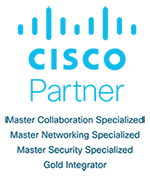Living in the Cloud and Modernizing Your Data Center – Part 1
Modernizing your data center — the right way — with a focus on the Cloud.
By Christian Chavez, Data Center Cloud Solutions Architect
The Cloud is a term often thrown around but rarely nailed down. But it’s essential to do so because of its ubiquity in today’s world. Businesses and consumers use the Cloud every day, even if they don’t realize it.
The problem is not every business that uses cloud technology uses it effectively — or even correctly. Some have tried solutions that left a sour taste in their mouths. It can seem easier to turn back to outdated solutions rather than reaping the benefits when cloud solutions are deployed in the right way.
In two episodes of Aspire Data Streams, we discuss modernizing data centers with the Cloud. We cover the definition of the Cloud, cloud optimization, security, applications, and more. Catch episode 1 here and episode 2 here.
What is the Cloud when it comes to your data center?
It’s important to start with the fundamentals.
Gartner defines the Cloud as “a style of computing where scalable and elastic IT-enabled capabilities are provided as a service to external customers using Internet technologies.”
Amazon Web Services (AWS), Google, and Microsoft’s Azure are the big three hyperscaling cloud services. Apple, Facebook, and other major companies leverage these or their own clouds in some way. Every business tries to provide a cloud-based solution for their internal and external customers.
And your internal and external customers are no different. They want a cloud experience that matches what they have come to expect from any consumer cloud. That begins with you making the experience transparent to them.
Once upon a time, storage, operations, and other data center services were tedious to deploy and maintain. The architecture was archaic. Manual hardware procurement and application rollout took significant amounts of time. Operations required hands-on staff, 24/7.
Cloud solutions have changed that. It’s good that the right resources are available to the people who need them, but these resources have to be built to be consumed in an “invisible” way. The whole process is abstract to most users — generally subscription-based with a simple monthly payment.
There are two main drivers of cloud adoption, both focus on modernization:
Datacenter modernization
Some organizations want a hybrid or multi-cloud-based solution. Others want to exit the data center space entirely. Building data centers with the necessary cooling is a capital expenditure, so migrating your data center to the Cloud instead of maintaining on-prem hardware while keeping costs low is a clear plus.
Application modernization
This approach can include monolithic legacy applications and consumer-based services. For example, you can leverage AWS as a microservice for a specific app. If you have a range of applications, these become modular. Using a microservice or part of a particular application, it’s easier to see how to make it more useful, streamlined, effective, and profitable.
While we focused on modernizing your data center in this part of the series, we’ll dive into why you need to revamp your data center by moving to the cloud in the next post.
 Aspire Technology Partners is a Cisco Gold Certified Partner engrained in solution pillars that set us apart as a true Cisco solutions provider. We are committed to the continuous improvement of expertise and skillsets around Cisco initiatives that enable us to help and guide customers in the adoption and management of technology architectures designed to transform their organization. We hold Cisco Master Specializations in Collaboration, Security, Cloud & Managed Services and is one of only 25 partners in the US to receive the Cisco Advanced Customer Experience Specialization.
Aspire Technology Partners is a Cisco Gold Certified Partner engrained in solution pillars that set us apart as a true Cisco solutions provider. We are committed to the continuous improvement of expertise and skillsets around Cisco initiatives that enable us to help and guide customers in the adoption and management of technology architectures designed to transform their organization. We hold Cisco Master Specializations in Collaboration, Security, Cloud & Managed Services and is one of only 25 partners in the US to receive the Cisco Advanced Customer Experience Specialization.


